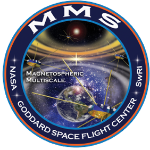Supercritical, collisionless shockwaves are known to exhibit nonstationarity, i.e. time-dependent structures even under steady upstream conditions, which can contribute to heating and particle acceleration. Here we examine the evolution of nonstationary structures using MMS observations while in string-of-pearls formation between 25th January and 13th March 2019. Burst data from this period was examined to find candidate shock crossings which demonstrate nonstationarity, including cyclic shock reformation and surface ripples. These data include examples of extended rippled shock front crossings (2019-02-05 05:12 UTC is shown). However, given the string-of-pearls formation we cannot use standard multi-spacecraft methods to resolve ripple wavelength and phase speed. Instead, a new method is presented that uses a model of ion specular reflection at the shock front to probe its spatial gradient. In simulations, the reflected ion beam is automatically isolated in the ion distribution at the shock front using kmeans clustering. Assuming a trivariate Gaussian distribution the coplanar velocity components can then be sampled to determine a surface gradient each time the spacecraft traverses the ripple. This approach will be used to investigate the time-dependence of ripple properties both as they reform at oblique crossings and at the steadier quasi-perpendicular shock.

 PDF version
PDF version
